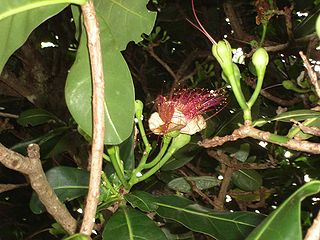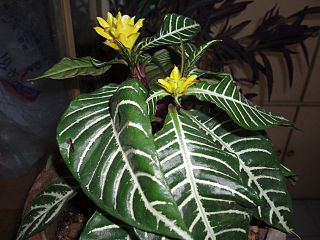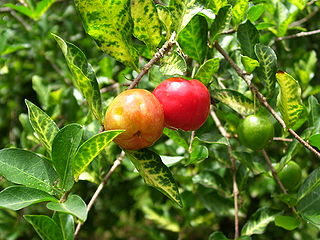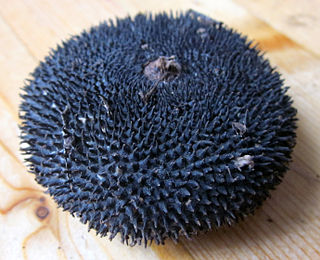
Quassia is a plant genus in the family Simaroubaceae. Its size is disputed; some botanists treat it as consisting of only one species, Quassia amara from tropical South America, while others treat it in a wide circumscription as a pantropical genus containing up to 40 species of trees and shrubs.

The Anacardiaceae, commonly known as the cashew family or sumac family, are a family of flowering plants, including about 83 genera with about 860 known species. Members of the Anacardiaceae bear fruits that are drupes and in some cases produce urushiol, an irritant. The Anacardiaceae include numerous genera, several of which are economically important, notably cashew, mango, Chinese lacquer tree, yellow mombin, Peruvian pepper, poison ivy, poison oak, sumac, smoke tree, marula and cuachalalate. The genus Pistacia is now included, but was previously placed in its own family, the Pistaciaceae.

Tibouchina is a neotropical flowering plant genus in the family Melastomataceae. Species of this genus are subshrubs, shrubs or small trees and typically have purple flowers. They are native to Mexico, the Caribbean, and South America where they are found as far south as northern Argentina. Members of this genus are known as glory bushes, glory trees or princess flowers. The name Tibouchina is adapted from a Guianan indigenous name for a member of this genus. A systematic study in 2013 showed that as then circumscribed the genus was paraphyletic, and in 2019 the genus was split into a more narrowly circumscribed Tibouchina, two re-established genera Pleroma and Chaetogastra, and a new genus, Andesanthus.

The Lecythidaceae comprise a family of about 20 genera and 250–300 species of woody plants native to tropical South America, Africa, Asia and Australia.

Virola is a genus of flowering plants in the nutmeg family, Myristicaceae. It includes medium-sized trees native to rainforests of the tropical Americas, ranging from southern Mexico to Bolivia and southern Brazil. Species are known commonly as epená, patricá, or cumala. They have glossy, dark green leaves and clusters of tiny yellow flowers, and may emit a pungent odor.

Aphelandra is a genus of over 200 species of flowering plants in the family Acanthaceae, native to tropical regions of the Americas.

Vismia is a genus of flowering plants in the family Hypericaceae. Members of the genus are small trees and shrubs found in tropical and subtropical areas of Central America and South America. Including the countries of Belize, Bolivia, Brazil, Colombia, Costa Rica, Ecuador, El Salvador, French Guiana, Guatemala, Guyana, Honduras, Mexico, Nicaragua, Panamá, Peru, Suriname, Trinidad-Tobago and Venezuela.

Malpighia is a genus of flowering plants in the nance family, Malpighiaceae. It contains 108 species of shrubs or small trees, all of which are native to the American tropics, ranging from Texas through Mexico, Central America, and the Caribbean to Venezuela, Colombia, and Ecuador. The generic name honours Marcello Malpighi, a 17th-century Italian physician and botanist. The species grow to 1–6 m (3.3–19.7 ft) tall, with a dense, often thorny crown. The leaves are evergreen, simple, 0.5–15 cm (0.20–5.91 in) long, with an entire or serrated margin. The flowers are solitary or in umbels of two to several together, each flower 1–2 cm (0.39–0.79 in) diameter, with five white, pink, red, or purple petals. The fruit is a red, orange, or purple drupe, containing two or three hard seeds. M. emarginata, the acerola, is cultivated for its sweet and juicy fruits, which are very rich in vitamin C.

Barleria is a genus of plants in the family Acanthaceae. It includes 303 species native to the tropics and subtropics, including the Americas from Mexico to northern South America, sub-Saharan Africa, Egypt and the Arabian Peninsula, the Indian subcontinent, Indochina, southern China and Taiwan, parts of Malesia, and New Guinea.

Anemone hepatica, the common hepatica, liverwort, liverleaf, kidneywort, or pennywort, is a species of flowering plant in the buttercup family Ranunculaceae, native to woodland in temperate regions of the Northern Hemisphere. This herbaceous perennial grows from a rhizome.

Apeiba is a genus of shrubs or trees in the family Malvaceae. It includes ten species native to the tropical Americas, ranging from northeastern Mexico to Bolivia and southeastern Brazil.

Perebea is a genus of flowering plants in the family Moraceae. It includes ten species native to the tropical Americas, ranging from Nicaragua to Bolivia and central Brazil.

Thyrsodium is a genus of plants in the family Anacardiaceae. It includes six species native to tropical South America, from Colombia to Bolivia and southeastern Brazil.
Tapirira obtusa is a species of plant in the family Anacardiaceae. It is native to South America and can be found in Bolivia, Brazil, Colombia, Ecuador, French Guiana, Guyana, Suriname, and Venezuela.

Pariana is a genus of flowering plants in the grass family. It is native to tropical Central and South America.

Engellaria obtusa is a species of flowering plant in the family Caryophyllaceae known by the common names Rocky Mountain chickweed, blunt-sepaled starwort, and obtuse starwort. It is the sole species in genus Engellaria. It is native to western North America, from British Columbia and Alberta to California to Colorado, where it grows in moist areas in forests and on mountain slopes.

Hernandia is a genus of flowering plants in the family Hernandiaceae. It was named after the Spanish botanist Francisco Hernández de Toledo.

Matourea is a genus in the family Plantaginaceae. It includes nine species native to tropical South America and Nicaragua. The name Matourea refers to the town of Matoury.
Norantea is a genus of flowering plants belonging to the family Marcgraviaceae.

Paypayrola is a genus of flowering plants belonging to the family Violaceae.


















